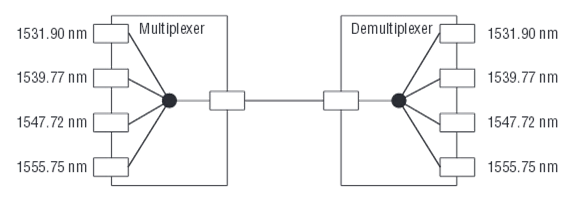With the rapid development of telecommunications, the demand for cable capacity is stronger more than ever. WDM (Wavelength Division Multiplexing) will be the preferred method to meet the needs. WDM systems are divided into different wavelength patterns, conventional/coarse (CWDM) and dense (DWDM). This post aims to make a comparison between CWDM and DWDM.
Wavelength Division Multiplexing is a technology which multiplexes a number of optical carrier signals onto a single optical fiber by using different wavelengths of laser light. This technique enables bidirectional communications over one strand of fiber, as well as multiplication of capacity. A WDM system uses a multiplexer at the transmitter to join the signals together, and a demultiplexer at the receiver to split them apart. With the right type of fiber it is possible to have a device that does both simultaneously, and can function as an optical add-drop multiplexer.
CWDM is the technology of choice for cost efficiently transporting large amounts of data traffic in telecoms or enterprise networks.
DWDM is an optical technology used to increase bandwidth over existing fiber optic backbones.
Comparison between CWDM and DWDM will be illustrated from the following aspects:
- Channel Numbers: DWDM can fit 40-plus channels into the same frequency range which is twice of CWDM can fit. CWDM is used more often than DWDM due to the cost factor. Now that cabling and transmission has become more affordable, DWDM takes place of CWDM. CWDM is defined by wavelengths, while DWDM is defined in terms of frequencies.
- Modulated laser: Unlike DWDM deploys cooled distributed-feedback (DFB), CWDM is based on uncooled distributed-feedback (DFB) lasers and wide-band optical filters. These technologies provide several advantages to CWDM systems such as lower power dissipation, smaller size, and less cost. The commercial availability of CWDM systems offering these benefits makes the technology a viable alternative to DWDM systems for many metro and access applications.
- Transmission Distance: Another major difference between the two is that DWDM is designed for longer haul transmission, by keeping the wavelengths tightly packed. It can transmit more data over a significantly larger run of cable with less interference than a comparable CWDM system. If there is a need to transmit the data over a very long range, the DWDM will likely be the priority in terms of functionality of the data transmittal as well as the lessened interference over the longer distances that the wavelengths must travel. CWDM cannot travel long distances because the wavelengths are not amplified, and therefore CWDM is limited in its functionality over longer distances. Typically, CWDM can travel anywhere up to about 100 miles (160 km), while an amplified dense wavelength system can go much further as the signal strength is boosted periodically throughout the run. As a result of the additional cost required to provide signal amplification, the CWDM solution is best for short runs that do not have mission critical data.
From the comparison above, we can know both the benefits and drawbacks of CWDM and DWDM. If the transmission distance is short and cost is low, then CWDM may be your first choice. On the contrary, you can consider DWDM. For more information about CWDM and DWMD, you can visit Fiberstore.







